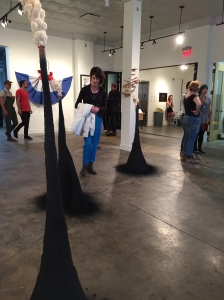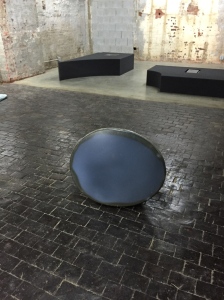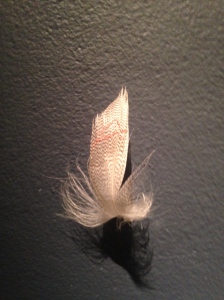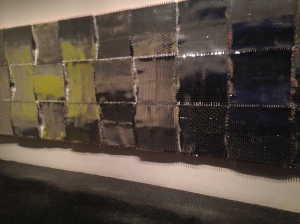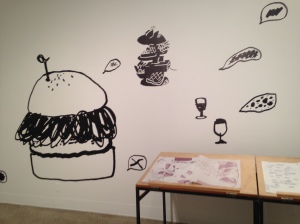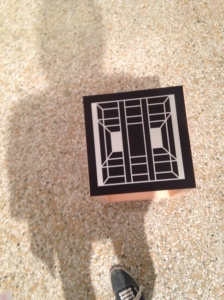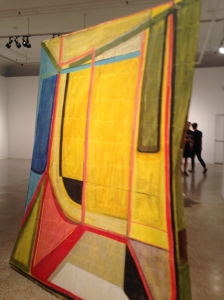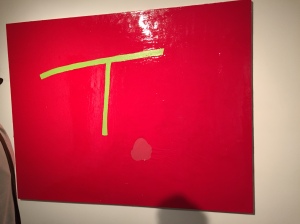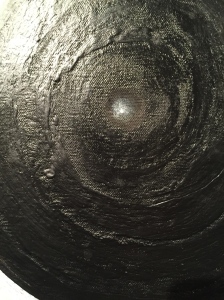The VCU MFA Exhibitions have begun, swiftly replacing the undergraduate exhibitions. Artists were carrying their works back to their designated buildings within a day of seeing them hanging in the Anderson. Its unfortunate they can’t be up longer considering everyone is busy preparing for finals but in their places now are graduate students, able to present a body of work.
The Depot is currently housing works that address living with nature both in life and decay. Chris White‘s sculptures protrude from walls and erupt from the ground up, large scale renditions of miniature worlds overlooking rotting tree branches, rusted and purpled.
Besides White’s is Alex Arzt‘s installation Dispersal, of live plants in wooden and ceramic bases. On the surrounding walls are box framed videos of people and plants, against solid background of yellows and greens expressing the potent life force of both plant and human. We fall into Dirt Time, Plant Thinking, a screen projecting the process of the series initially hidden by the stalks of plants. Once again the viewer is made to think miniature as the camera pans through the city foundation that is a garden bed.
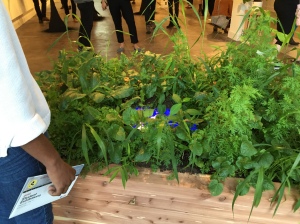
Alex Artz, “Dirt Time, Plant Thinking,” Eastern red cedar, soil, found seeds, LCD monitor, media player, HD Video; Plants: Broadleaf dock, common tansy, burdock etc.
The adjoining room holds works by Noa Glazer and Stephen Fuller. Initially entering the room, it appeared as though maybe we had missed something. A table is spotted with recording equipment and brush enclosing a broken statue conjoined with chains and a camera seemingly pulled up from the ocean’s depths, we hear the water lapping at its base.

“Fliers From Dry Season,” cast salt, reticulated foam, rubber, silicone, glass, slip, steel, ceramic blanket, muslin, dissolvable film, squid ink and plaited straw
On the ground, a large head lighting device backed by black foam boards and straw structures fully sets us awash on shore. Combined with scattered movie posters the fusion of technology and classical figure as remaining remnants of time suggest we have yet if ever to escape past ideals no matter how we advance.
Also in the Depot are costume and costume drawings by Emily Atkins for The Striker ballet.
Over at the Anderson the power of nature continues as a theme in Hillary Waters‘ series Fallen, Lifted. Probably the most criticized from what I overheard many deemed Waters’ pieces to be “pretty objects” quickly dismissing the strenuous tension created in the room. Aria for the Golden Hour hangs James’ River stones, attached with thread, from leafs somehow capable of holding a mass greater than themselves.
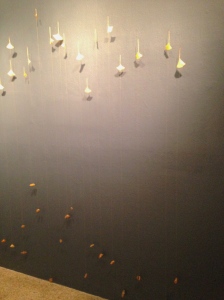
Hillary Waters, “Aria for the Golden Hour,” gingko tree leaves, James River stones, hand dyed thread
The same threads wrap around woods on the opposing wall, almost blending with the bark yet scarring it underneath; there’s a mountain sewn in a feather.
Leigh Suggs‘ Trying to Exit Here is a broad reflective eye bender of woven mylar tape refracting each exit from the piece the eye attempts to make. Only close enough could I see past the bends in the tape,through to the white wall behind the inter latching pieces, giving the eye a rest, no longer concerned with escaping the frenzy. In comparison, The Ease of Seeing, reflected by the surrounding metallic pieces settles the eye. Circles punched in neon yellowed Yupo paper naturally folding off the wall, revealing speckled shadows beneath, releases the strain caused by the rest of the pieces.
In another area, Graphic Design student Xi Lu asks if we are ready to be mixed, possibly taped outlines of emptying glasses and food on the wall with buzzed speech bubbles.
Adjacent to these are Sarah Baugh‘s pieces hanging out from the wall and tabled on the floor dropping the viewer into another realm as questions about origin persist. Sylvia begins reading a poem from one of the wall works only to find it is a definition. A pamphlet to accompany the series admits to reusing scrambled words but questions if it makes the sincerity any different. When sharing with others comes down to such reusing and reposting, how skewed are our intentions to connect through third parties?
In the last corner of this room Yaeyoung Park establishes a station inviting you to create a zine from Nationality, Genes, and Language. Each paper holds symbols with small words such as “unitary” and “simultaneous” printed at the top and a definition of the category on the sides. Together each is a statement in itself yet is dependent on the other to produce a heterogeneous mix of the maker.
Josh Thorud projects presumably Indigestion on one wall with a TV propped sideways on the opposite wall’s corner screening Limelight. Forcing a back and forth of looking we see Thorud bathing in chocolate milk, watching a TV inside of a fridge while the TV in the viewing room fades through various neon pinks, purples and blues. This to and fro is echoed in Alex Bruno‘s piece, an interplay of two screens facing one another, seemingly in conversation if machines could relate.
Matthew Yaeger‘s use of color and line on hollow wooden frames produce windows within windows across from Grace Weaver‘s paintings who’s patterns automatically animate the scenes and points of view bring us forth into the works.
Harris Johnson‘s paintings demonstrate effects of layering requiring shifting in and out of light to grasp all the subtleties of the paint. It is the impression of a body, of a ship swaying, that previously invisible, become impossible to unsee. Black Hole swirls paint round and round the canvas drawing you to the center, where blank canvas, simplicity and peace, seems so distant in comparison to the layers built around it.
Andrew Francis‘ exhibit is in a room in which requires a wait, to have a personal experience. We were told is was worth the line but ran into closing time.
These works are on view until April 26th when Round 2 will replace them.
